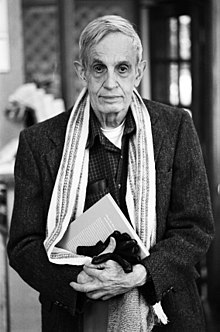
Back John Forbes Nash Jr. ALS John Forbes Nash AN جون فوربس ناش Arabic جون فوربس ناش ARZ জন ফ'ৰ্বছ্ নাশ্ব, কনিষ্ঠ Assamese John Forbes Nash AST Con Neş Azerbaijani جان فوربز نش AZB John Forbes Nash, Jr BAT-SMG Джон Форбс Нэш Byelorussian
John Forbes Nash Jr. | |
|---|---|
 Nash in the 2000s | |
| Born | June 13, 1928 Bluefield, West Virginia, U.S. |
| Died | May 23, 2015 (aged 86) |
| Education | |
| Known for | |
| Spouses |
|
| Children | 2 |
| Awards |
|
| Scientific career | |
| Fields |
|
| Institutions | |
| Thesis | Non-Cooperative Games (1950) |
| Doctoral advisor | Albert W. Tucker |
John Forbes Nash, Jr. (June 13, 1928 – May 23, 2015), known and published as John Nash, was an American mathematician who made fundamental contributions to game theory, real algebraic geometry, differential geometry, and partial differential equations.[1][2] Nash and fellow game theorists John Harsanyi and Reinhard Selten were awarded the 1994 Nobel Prize in Economics. In 2015, he and Louis Nirenberg were awarded the Abel Prize for their contributions to the field of partial differential equations.
As a graduate student in the Princeton University Department of Mathematics, Nash introduced a number of concepts (including Nash equilibrium and the Nash bargaining solution) which are now considered central to game theory and its applications in various sciences. In the 1950s, Nash discovered and proved the Nash embedding theorems by solving a system of nonlinear partial differential equations arising in Riemannian geometry. This work, also introducing a preliminary form of the Nash–Moser theorem, was later recognized by the American Mathematical Society with the Leroy P. Steele Prize for Seminal Contribution to Research. Ennio De Giorgi and Nash found, with separate methods, a body of results paving the way for a systematic understanding of elliptic and parabolic partial differential equations. Their De Giorgi–Nash theorem on the smoothness of solutions of such equations resolved Hilbert's nineteenth problem on regularity in the calculus of variations, which had been a well-known open problem for almost sixty years.
In 1959, Nash began showing clear signs of mental illness, and spent several years at psychiatric hospitals being treated for schizophrenia. After 1970, his condition slowly improved, allowing him to return to academic work by the mid-1980s.[3]
Nash's life was the subject of Sylvia Nasar's 1998 biographical book A Beautiful Mind, and his struggles with his illness and his recovery became the basis for a film of the same name directed by Ron Howard, in which Nash was portrayed by Russell Crowe.[4][5][6]
- ^ Goode, Erica (May 24, 2015). "John F. Nash Jr., Math Genius Defined by a 'Beautiful Mind,' Dies at 86". The New York Times.
- ^ "John F. Nash Jr. and Louis Nirenberg share the Abel Prize". Abel Prize. March 25, 2015. Archived from the original on June 16, 2019. Retrieved May 27, 2015.
- ^ Cite error: The named reference
Nasar1994was invoked but never defined (see the help page). - ^ "Oscar race scrutinizes movies based on true stories". USA Today. March 6, 2002. Retrieved January 22, 2008.
- ^ "Academy Award Winners". USA Today. March 25, 2002. Retrieved August 30, 2008.
- ^ Yuhas, Daisy (March 2013). "Throughout History, Defining Schizophrenia Has Remained A Challenge (Timeline)". Scientific American Mind. Retrieved March 2, 2013.